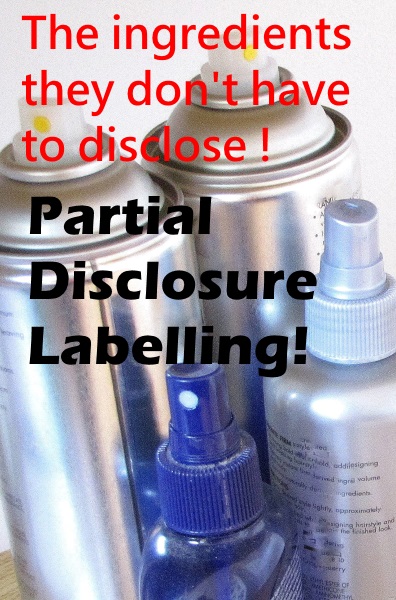 What Partial Disclosure Product Labelling Means
What Partial Disclosure Product Labelling Means
Do you know exactly What Partial Disclosure Product Labelling Means? You may have already had a read of my article Non-Toxic Labelling – What Does It Really Mean? Is It A Legal Requirement? It Is Regulated? If you haven’t I strongly suggest you do.
Basically labelling laws for the product safety of many products sold both in Australia and the USA, are dubious at best and downright dangerous and deceitful at their worst.
The huge grey area where manufacturers can get away with NOT listing some ingredients is known as ‘Partial Disclosure Labelling’
What Is Partial Disclosure Labelling?
See first The legal definition of Partial Disclosure
Partial disclosure means you are only been told part of the story. When it comes to labelling, or disclosing the ingredients of a product, then partial disclosure means you are only been informed about some of the ingredients that the products in question contains.
Is this fair? Is this safe? I think not to both.
Take for example if you ethically wanted to avoid using Palm Oil, this is near impossible, as it would mean you would have to eliminate any product that contained the ingredient ‘vegetable oil’. To date, food manufacturers do not have to list exactly what vegetable oil they are using in their products.
Here are some other examples of slippery labelling claims:
- Labelling a product ‘All-Natural’, or ‘Contains Natural Ingredients’, is an extremely clever marketing tool. Just because something is ‘All-Natural’, does not mean it is harmless – Asbestos is ‘All Natural’. The ‘Contains Natural Ingredients’ label is widely used and even if a product does contain some natural ingredients that are beneficial to our health, that doesn’t mean that there are no other harmful ingredients in the product. A shampoo containing Essential Lavender Oil and Jojoba Oil as ingredients, may still contain artificial colours and fragrances, sulphates and more.
- ‘Contains Organic Ingredients’ is allowed to be listed on products, even if they only contain a minuscule percentage of organic ingredients. Note – true organic ingredients must be ‘certified’ and this is not easy for a company to achieve. So the only way to make sure you are buying 100% organic, or products containing 100% organic ingredients, is to purchase only products that have official, ‘Organic Certified’ logos on them.
- ‘Unscented’ means that there is no ‘nice’ fragrance to the product, but it doesn’t mean that the product doesn’t contain specialized masking agents to neutralize the often unpleasant scents that some ingredients give off.
- ‘Derived From Natural Ingredients’ is one of our favourites, as this is such a clever marketing tool. The actual dictionary definition of the word ‘dervived’ is this: “formed or developed from something” or, “to obtain or receive from a source”. So this means just because an ingredient is originally ‘derived’ from an all-natural product, doesn’t mean that once it is extracted from its natural source and then chemically processed, that it still remains natural and safe!
Labelling Of Products For Illusion
Labelling can create numerous illusions about a product. Take for example the label ‘100% cotton’. Yes, 100% cotton will generally let the skin breathe better than synthetic materials but, that is about as natural and pure as it gets. Unless the cotton and all the dyes are certified organic, then the 100% cotton, (including cotton products such as makeup pads, cotton-buds and balls) can contain pesticide & fungicide residues, synthetic chemical dyes and flame retardant chemicals.
Another thing you may have noticed is that many products in the Pharmaceutical Industry only list the ‘Active Ingredient’ on the packaging and nothing else. This is allowed by law, but it leaves the consumer in the hands of the government labelling system as to what they deem is safe enough for the general public. The listing of all the other ‘non-active’ ingredients such as, artificial sweeteners, colouring and flavouring are nowhere to be found.
Shopping Safely – Learning To Read Labels
To see my safety tips on how to read between the lines on product labels, so you can ensure you are shopping for safer products from honest companies, see the tips listed in my article Non-Toxic Labelling – What Does It Really Mean? Is It A Legal Requirement? It Is Regulated?
Leave a Reply
You must be logged in to post a comment.